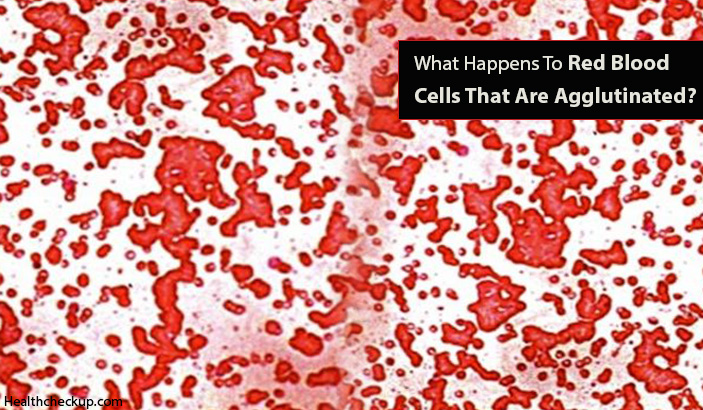Before knowing what happens to red blood cells that are agglutinated, this article will take you through why and how that red blood cells are agglutinated.
Some Basic Terminologies
- Agglutinogens are antigens present on cell membranes of red blood cells
- Agglutinins are antibodies against agglutinogens, present in the plasma
- Agglutination comes from the Latin word “Agglutinare” which means “Clumping’ or “To Glue”
Agglutination of red blood cells is caused by antigens present on cell wall membrane in presence of suitable agglutinins (antibodies). The classical ABO grouping system is based on the presence or absence of the type of agglutinogens on the cell membrane of red blood cells. It depends upon the presence of mainly A and B agglutinogens.
Causes for Abnormal Red Blood Cell Agglutination
Cold Agglutinin Disease – Antibodies, usually IgM bind to red blood cells at low temperatures and cause them to agglutinate. Cold agglutinin disease can be acute or chronic depending upon the nature of the antibody.
Infectious Organisms – In association with infectious organisms like Epstein Barr Virus and Mycoplasma Pneumonia.
B Cell Lymphoma – Chronic cold agglutinin disease can affect elderly in association with an underlying low grade B-cell lymphoma.
Cryoglobulinemia – A condition in which the blood contains large amounts of the protein cryoglobulin.
Blood Transfusion – During blood transfusion when there is a mismatch between cells of donor and recipient.
Example: when a person with blood group A is being given blood of a person whose blood group is B, the recipient will have a transfusion reaction.
Other – Conditions like Autoimmune Hemolytic Anemia, Raynaud’s disease and Waldenstrom’s macroglobulinemia (lymphoplasmacytic lymphoma).
In children, it is associated with congenital syphilis.
Since agglutination of red blood cells occurs due to serious illnesses, it is difficult to detect them since patients will exhibit signs and symptoms specific to the underlying causative illness.
Know More about Reactions After Blood Transfusion
What Happens to Red Blood Cells that are Agglutinated?
In Case of Cold Agglutinin Disease
- IgM antibodies bind to red blood cell surface which causes red blood cells to agglutinate at temperatures lower than the normal body temperature.
- The bound antibodies activate the immune system and produce inflammation in order to eliminate the red blood cells causing damage to the red blood cell membrane.
- This results in both intra vascular and extra vascular hemolysis (destruction of red blood cells). The process is called Complement Mediated Hemolysis.
In Transfusion Mismatch
- For blood transfusion, it is important that the blood group and Rh factor of the donor and recipient match.
- When the blood group of transfused blood is incompatible, red blood cells from the donated blood will begin to clump together in recipient’s circulation.
- The clumped red blood cells tend to block blood vessels and stop the flow of blood causing tissue ischemia.
- The clumped red blood cells are damaged rapidly which releases large amounts of hemoglobin in circulation.
- Hemolysed or destroyed red blood cells also release bilirubin. Excess bilirubin results in hemolytic jaundice.
- Renal vasoconstriction (decrease in diameter of blood vessels of kidneys) occurs in response to toxic by products of excessive breakdown of red blood cells.
These events lead to reduced blood pressure and compromised blood flow to the kidneys. Acute renal failure eventually occurs.
Whichever may be the cause, red blood cells that are agglutinated are eventually destroyed by the body’s complement/ immune system. Rapid destruction of these clumped red blood cells causes the release of by-products of hemoglobin which can cause a serious chain of reactions in the body as seen in transfusion mismatch.
Other fate of clumped red blood cells is that they have to be destroyed in the spleen, which means that the work of spleen is increased in such circumstances. This can cause the spleen to become enlarged (splenomegaly).
The workload of the liver also increases sharply as it has to metabolize all the bilirubin released from destroyed red blood cells. This may result in an enlarged liver (hepatomegaly).
In case of infections, agglutinated red blood cells are destroyed rapidly. It usually stops once the disease period is over. Whereas in some patients this process may continue and result in a chronic illness.
Dr. Himanshi is a Homoeopathic consultant and currently working as a lecturer in Post-graduate faculty of Homeopathy, Parul University, Vadodara. Completed BHMS and MD in Homeopathy in January 2018 and also has a clinical experience of about 6 years. Personal interests include reading, spending time with family and traveling.









